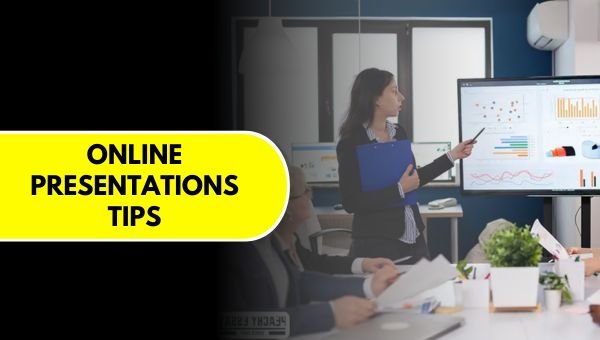Online presentations have many things in common with face-to-face presentations, but there are some important differences that are essential if they are to be equally effective. There are certain particularities of online presentations that can go against you or in your favor if you take them into account. Of those, we are going to see 10.
1. You can not maintain eye contact
In many cases, when making an online presentation, the speaker cannot see the listeners and maintain eye contact with them. This prevents us from receiving instant feedback from our audience to assess how they are receiving our message and make corrections on the spot. You can only rely on your presentation deck or PPT templates education that will help you deliver your message.
 It is advisable to try to find a tool that allows you to see your interlocutors. There are many applications that you can use to connect with your audience while presenting, like Google Meet and Skype. You just needed to make sure you had a stable internet connection to avoid interruptions.
It is advisable to try to find a tool that allows you to see your interlocutors. There are many applications that you can use to connect with your audience while presenting, like Google Meet and Skype. You just needed to make sure you had a stable internet connection to avoid interruptions.
2. You do not get emotional feedback from the public
When you present to an audience, you tend to receive their encouragement and energy. That energy serves as motivation for you to continue adding an adequate rhythm to the presentation without falling into a monotonous and boring tone of voice. This feedback keeps you engaged in your presentation, and that makes it easier for your audience to be as well.
However, when presenting online, this possibility of capturing the energy that the public transmits is much more difficult. So, we will have to carry out personal self-motivation work so as not to fall into monotony and discouragement and so that our audience can perceive our enthusiasm.
3. You have restricted movements
In general, in online presentations, the speaker can be seen through a webcam or similar device. In those cases, you, as a speaker, cannot get out of the field of view of the camera. You cannot get up, make movements with your arms, or move around the room where you are unless you have a camera and someone to handle it.
4. The close-up magnifies the details
Presenting through a webcam usually involves showing the public a close-up of ourselves. That means that everything you do on camera will have much more impact than when they do it live from the stage.
For example, looking away from the screen is much more noticeable with the webcam than live. It can allow you to look at the shoulders of someone in the audience, and that person and some others behind them will perceive that you are looking at them. This is known as the magic V. On the other hand, if you stop looking at the PC’s camera to consult the computer screen itself, it will be noticed that you have diverted your eyes and are no longer looking at them.
Also, any small gesture is much more noticeable than when he does it on stage.
5. You need to put less emphasis on everything
When you are on stage, you must project your voice so that it reaches the last row of the auditorium. You also need to exaggerate your gestures so that they are perceived by viewers further away. However, in online presentations, you don’t need to raise the pitch of your voice because you only have to reach the camera’s mic. And any exaggeration can be annoying or fake.
6. The background can generate noise
Most sets are already designed so that the background does not distract the audience. When you are presenting, you take the absolute lead (unless you use slides, depending on which slides). Instead, I have seen many online presentations in which the speaker speaks from his office desk, showing the bookstore, other colleagues, etc.
When you have to make presentations online, make sure to look for a background without distracting elements. I usually choose a white wall. I use the ironing board as a table on which to place the computer, and I adjust it to the necessary height so that I can be seen correctly sitting in a chair against the wall.
7. They only see you, not what surrounds you
Except for the background, everything else you have out of camera range goes unnoticed by viewers. This means that you can surround yourself with other devices that make your work easier. For example, if you have another computer or a tablet, you can control what happens on social networks while you are present. Or you can have reference material on hand in case, at any time, it is necessary.
8. The slides compete with your image
Although there are some solutions that allow you to simultaneously display your image and your slides, typically your listeners can only see one of the two at a time. Therefore, when you show your slides, you can only accompany them with your voice.
This means that the design you use must direct the gaze of your audience by itself to make it easier for them not to get lost. In this sense, animations can be more useful than ever.
9. Technology is critical
When being on stage, technology fails you, you still have the possibility of moving forward and adapting to new circumstances. It’s not easy, you have to admit, but that doesn’t mean it can’t be done. On the other hand, in online presentations, if the technology fails, there is no way to continue with the presentation. It is for this reason that you should check that everything works correctly before starting. Better a few days before to have time to act in case of detecting an anomaly. It may even be advisable to have a plan B prepared.
10. Listeners are already connected
Getting feedback from the audience is the best way to continue evolving as a presenter. The problem is that if you do not enable a system to be able to evaluate yourself anonymously, it is very difficult for listeners to be honest when giving you their opinion. Especially if they are your subordinates.
There are systems to create online questionnaires to get that feedback or even to answer questions during the presentation. But it is difficult for the audience to later connect to the Internet to answer such questionnaires.
The advantage of online presentations is that listeners are already connected, so asking for feedback with just-in-time online forms is much more effective.







